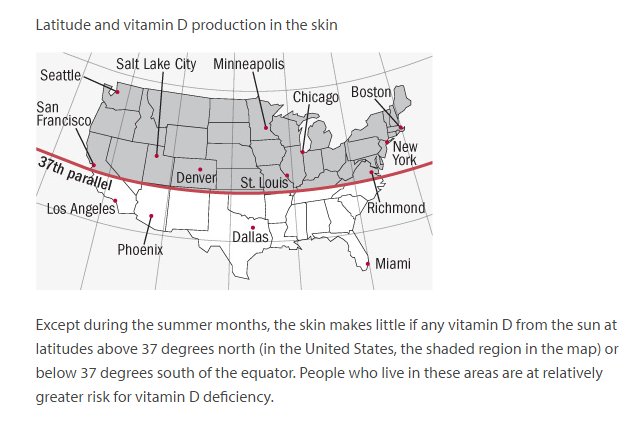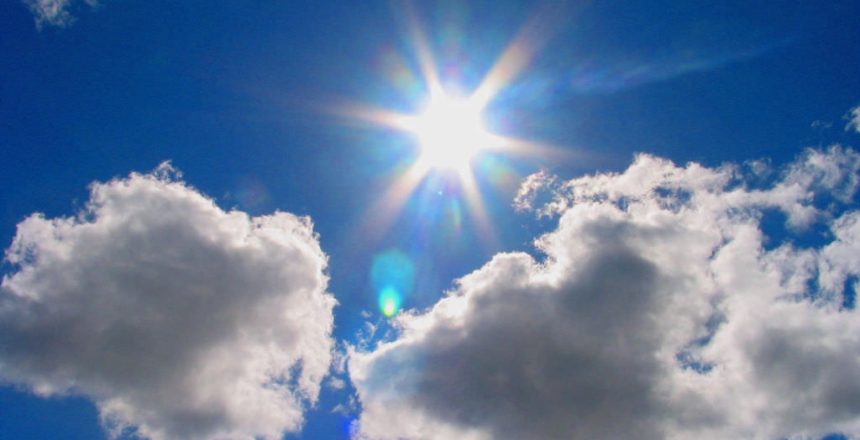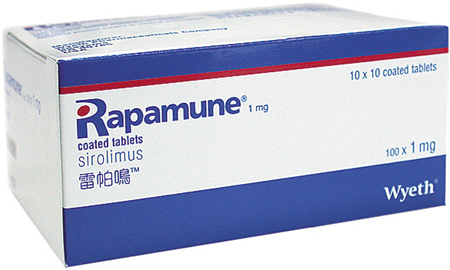Do we get enough vitamin D for good health? Many people are vitamin D deficient, and what’s more, there’s evidence that the amount of vitamin D in supplement form that relieves deficiency is greater than previously thought. How much vitamin D do we need?
The big vitamin D mistake
The big vitamin D mistake is that health authorities, in particular the Institute of Medicine, greatly underestimated the amount of supplemental vitamin D that will make someone vitamin D sufficient, or to keep that person sufficient.
The Institute of Medicine calculated that 600 IU of vitamin D daily would keep most (97.5%) people at a vitamin D blood level of greater than 50 nmol/L, which in more familiar units is 20 ng/ml. However, their calculation was shown to be a mistake.
Without going into all the details (which you can read in the paper), the authors calculated that 8895 IU of vitamin D daily would be needed to get most people above the 50 nmol/L limit. Huge difference. The authors also state, “As this dose is far beyond the range of studied doses, caution is warranted when interpreting this estimate. Regardless, the very high estimate illustrates that the dose is well in excess of the current RDA of 600 IU per day and the tolerable upper intake of 4000 IU per day.”
A different group of scientists confirmed that this estimate was in the ballpark, with about 7000 IU of vitamin D daily, from all sources including the sun, needed to achieve 50 nmol/L in most people.
A meta-analysis of studies on vitamin D and mortality showed an inverse correlation between vitamin D blood levels and death rates. See chart below. At vitamin D levels that indicate clear deficiency, death rates were almost twice as high as when blood levels were normal.
 The meta-analysis found that the point at which higher levels were no longer associated with lower death rates with statistical significance was 36 ng/ml, or about 90 nmol/L. Assuming this analysis is correct, people should strive for blood levels at least that high. That’s about 80% higher than what the Institute of Medicine recommended.
The meta-analysis found that the point at which higher levels were no longer associated with lower death rates with statistical significance was 36 ng/ml, or about 90 nmol/L. Assuming this analysis is correct, people should strive for blood levels at least that high. That’s about 80% higher than what the Institute of Medicine recommended.
A pediatrician, Dimitrios T. Papadimitriou, calls the calculations of the Institute of Medicine the Big Vitamin D Mistake. He writes:
Since all-disease mortality is reduced to 1.0 with serum vitamin D levels ≥100 nmol/L, we call public health authorities to consider designating as the RDA at least three-fourths of the levels proposed by the Endocrine Society Expert Committee as safe upper tolerable daily intake doses. This could lead to a recommendation of 1000 IU for children <1 year on enriched formula and 1500 IU for breastfed children older than 6 months, 3000 IU for children >1 year of age, and around 8000 IU for young adults and thereafter. Actions are urgently needed to protect the global population from vitamin D deficiency.
Note that these amounts of vitamin D are from all sources put together: sun, food, and supplements.
A review on vitamin D intake concluded that the maximum safe dose, or Tolerable Upper Intake Level, is 10,000 IU daily. That doesn’t necessarily mean that this is the best dose, but that no toxicity has been seen in human clinical trials at that dose. Higher doses of vitamin D can be toxic. In contrast, the Endocrine Society recommends an upper limit of 4,000 IU daily.
Vitamin D toxicity appears to be rare. The media recently reported on a study on vitamin D usage and misinterpreted it to claim that it’s dangerous to supplement with vitamin D.

Conclusion
Low blood levels of vitamin D are associated with higher death rates.
The amount of vitamin D needed to attain levels associated with better health have been underestimated.
The only certain way to know whether you have adequate vitamin D is through a blood test.
Getting vitamin D through sun exposure is the best way to get enough vitamin D, one reason being that sun exposure has other benefits. But as we saw above, for many people, there’s not enough sun to increase vitamin D blood levels outside the summer months.










34 Comments
There are common genetic variants that cause people (like me) to need extra high intake of vitamin D. I recently learned about rs2282679 from Rhonda Patrick at FoundMyFitness.com.
P.D. – have you read some of Chris Kresser’s articles on Vitamin D? He feels that a level of 35-60 ng/ml is optimum for most people, and that anything over 70 ng/ml is potentially toxic. He cites quite a few references to support his view. https://chriskresser.com/vitamin-d-more-is-not-better/ I’d be interested in your opinion of Mr. Kresser’s analysis.
I’ve been having my Vit. D tested for quite a few years now, when I get my annual bloodwork done.
I live in Michigan, so it is difficult or impossible for me to get Vit. D from the sun for most of the year. I am currently supplementing with 5,000 IU daily, and that seems to keep my blood Vit. D around 55-60 ng/ml, which I’m thinking is about right, based on everything I’ve read (so far, anyway). I also take Vit. K2 daily, to make sure calcium gets to the right places in the body (bones), rather than arteries. I also eat quite a few free-range chicken eggs, which I understand are pretty high in Vit. K2 also.
I figured this out a decade ago, from general principles, and began taking 2000 IU daily. Then I ran into some research that had been done back in the 1930s where megadoses of D helped people with arthritis….sorry no link. Those experiments were discontinued, but suggested that even very large doses were tolerated, more than 50,000 IU. I get a fair amount of sun here in southern AZ, so not sure I need to increase the supplement, and haven’t done so.
P.D. and Peter,
I read this book awhile back while I was researching more information on Vitamin D. Jeff cites studies in his book and talks about the importance of Vitamin K as well. It’s an interesting read for sure.
https://www.amazon.com/Miraculous-Results-Extremely-Sunshine-Experiment/dp/1491243821/ref=asap_bc?ie=UTF8
-Matt
Sometimes I feel big gov don’t like us too much.
You got that right!
I’ve copied my comments from another Vitamin D post into this comment:
“I have a data point. Since last October (2016) I’ve indoor tanned weekly for 10-15 minutes resulting in a vitamin D, 25-Hydroxy result of 37.7 measured last week. I’ve taken no supplements and live at too high a latitude to generate vitamin D from the winter sun.
I used the tanning bed with the highest UVB rays, which is actually the cheapest. The tanning salon markets the high-UVA beds as “bronzing” while marketing the high-UVB beds as “burning”. With a military discount it only cost $5/session and was a nice, relaxing experience … kind of like getting a massage.
I began taking vitamin D supplements about 8 years ago as a way to cure the neck and back pain I would get each winter starting in November. While it worked to ease those muscular pains and gave me somewhat increased energy, I would also get really bad itching in different areas of my skin with the supplements.
With the tanning bed this winter I’ve had no pains, high energy, and none of the itching that the supplements gave me.
I’m a 5’11”, fairly muscular 205 lb 44-yo male. I’m a Caucasian who tends to tan pretty well without burning easily.
I stopped indoor tanning in May and started intentionally laying out in the sun once a week. About 15 minutes per side.
After a couple months of natural tanning my Vit D is about the same, 35.5. I guess I expected it would be higher from natural sun (I’ve heard of lifeguards with 60-70) but this level seems fine and in well above deficiency levels.”
This winter I’m continuing the indoor tanning but only every two weeks. I’m doing a carnivore diet ala Shawn Baker and will see if that reduces my Vitamin D requirement.
Why not just see what dosage works for you. My level was at 35 a couple of years ago. I started taking 2000 IU/day and it went up to 49. That tells me 2000 is about right, though I could probably go to 4000.
Here is something I posted yesterday on Josh’s site in a different context but which is relevant here:
I believe there is a fairly well-known aspect of some infections which use Vitamin D as part of their entry into cells. Dr. Ruscio did a podcast about Vitamin D several years ago and a large part of it was about this point, although I don’t remember the exact details. This type of infection tends to lower Vitamin D levels, but adding more D will enable and worsen the infection without raising blood levels, so it is worth looking up if you suspect you might have this issue.
PD, in researching this entry, did you find any evidence that Vit D levels over a certain level can be harmful in the long term? I have seen some articles discussing too low of D, but I don’t see much ink being spilled on how much is too much. And I am not referring to how much is toxic. Rather what is the upper bounds of long term optimal levels.
I think a reasonable upper-bound would be the maximum amount possible through sun exposure. I think this is in the 70s ng/ml, found in studies of Caucasian lifeguards.
Yes to that. And a study of people living in tropical climates with a lot of out of doors lifestyles. About the same, as I recall.
The only thing I’m aware of from long-term and moderately too high vitamin D is kidney stones. I haven’t read about this recently, but supposedly those Israeli lifeguards had a higher incidence of kidney stones, and that was from sun exposure only. Although, if I had to guess, a light-skinned Israeli lifeguard could conceivably have about the highest solar exposure in the world.
P.D.,
First off, thanks for another great article. I’ve read all your books and constantly refer clients to them. Awhile back I was reading your book Stop The Clock and I happened to come across Jeff Bowles work as well ( which I linked to above in another comment). Was curious if you read his works as his thinking seems to be in line with yours on a few topics especially in regards to aging and Vitamin D. He has a book on Melatonin which was quite fascinating as well where he discusses water restriction and life extension.
This article below is a great summary that lays out each disease and their correlation with Vitamin D levels.
https://jefftbowles.com/vitamin-d3-deficiency-causes-most-human-diseases/
Have you ever thought about doing a round table video for YouTube where you take a topic such as iron, aging, vitamin d etc and discuss?
Just throwing this out there but I know I can’t be the only one who would love to see in-depth discussions between:
1. You (@Mangan150)
2. Dr. Rhonda Patrick (@foundmyfitness)
3. Jay Campbell Jay Campbell (@TRTExpert)
4. Alexander J.A Cortes (@AJA_Cortes)
5. Dr. Joseph Mercola (@mercola)
6. Jeff T Bowles (@JeffTBowles)
7. Malcolm kendrick (@malcolmken)
8. Dr Sircus ( @drsircus)
Thanks, Matthew. I read Bowles’ book some years ago, and that’s an impressive article you linked to. I think I’ll go back and read his book again. I’d love to be a part of discussions like those you mention.
Anytime brother. Thanks for continuing to put out great content. Very much appreciate all the work you do for the wellness community and men in general.
@ P.D.,
I wasn’t previously aware of the Israeli study but wow on the surface at least that’s a stunningly high incidence of kidney stones. Twenty-four percent in presumably a young population.
The Israelis of course have some other factors to consider, like a very high use of seed oils high in omega-6 fatty acids, though I’m not sure how those impact kidney stones. Israel also has a very high amount of sunshine of course.
P.D.,
You’re always ahead of the curve. Mainstream medicine is slowly starting to see the importance of magnesium as well.
https://thedo.osteopathic.org/2018/02/jaoa-review-low-magnesium-levels-make-vitamin-d-ineffective/
In this study, they found that a Vit. D blood level of 32-36 ngMLl was best for minimizing the risk of all-cause mortality (levels lower and higher than that both resulted in increased mortality). https://academic.oup.com/jcem/article/98/5/2160/2537113
The results of this study don’t agree with several other studies I’ve reviewed that conclude that a higher level of Vit. D (at least 50 ng/ML) is best for optimizing health.
@Rob,
Probably good idea to pay attention to symptoms in addition to lab numbers. Prior to starting Vitamin D supplementation 10 years ago I would get intermittent neck and back pain starting in early November and lasting until spring. It was very difficult to turn my neck left when shifting lanes in a car for instance. I wish I had tested my levels back then. They probably would have been quite low < 20 nm/ml.
Also probably the less carbs in your diet the less need for Vitamin D.
So what works for large populations may not be optimal for a given individual.
There are some indications that ultraviolet light does even more in terms of biophotochemistry than just producing Vitamin D in the skin; and some researchers have suspicions that UV+skin-derived Vitamin D acts somewhat different than oral supplementation (the effect on some inflammatory markers was significantly different from both routes [sorry, I cannot find the study at the moment]).
So, while oral supplementation seems very beneficial, “making your own” through skin-exposure to UV radiation may have further advantages:
1.
You cannot overdose (when a certain amount of Vit.D is produced in the skin, an equilibrium of synthesis and destruction of Vit.D happens- naturally, perhaps evolutionary optimally, controlling radiation-induced Vit.D production). (Sidenote: In the 50s it was rather common in the US to give children injections with Vit.D in the order of 300.000 IU per shot (it was thought that compliance for oral supplementation would be too low, therefore doctors gave a big amount at once to make sure there would be no hypovitaminosis)- this is not longer done for some reason, but there were never reports of cases of hypervitaminosis from that practice, so the risks of oral Vit.D-supplementation, even in larger doses, seem to be very small, anyway.)
2.
Other photobiochemical factors that may be very important are also produced.
3.
It’s cheaper than any oral supplement, especially in the long run.
Tanning beds are suboptimal, because they mostly emit UV-A radiation (315–400 nm wavelength), while Vit.D-synthesis requires UV-B radiation (280–315 nm), the highest reactivity happens in a narrow spectral band between 295 and 297 nm.
Therefore, typical tanning lamps will achieve tanning (and aging of the skin, because UVA reaches deeper layers of skin), while being largely ineffective in generating Vit.D.
Specialized lamps with a high output of UV-B, specifically for Vit.D-generation, are available, but typically bulky, suitcase-sized boxes that cost in the order of 100s of dollars.
But there is a very suitable alternative:
It turns out that not only humans need UV-B radiation to prosper, but also the common lizard. Some of those are kept in terrariums by humans, and they need to be irradiated with UV-B to not only keep healthy, but not die soon.
For this application UV-B lamps are available that combine a high UV-B output with a low price and easy use (screw-in types for the regular Edison-sockets for household lamps).
https://www.exo-terra.com/en/products/reptile_uvb200.php
Just find a suitable socket (from a desk lamp etc.) and put the special lamp in, then irradiate your skin (to waste no extra time, it is efficient to do it while reading or brushing teeth etc., so it’s not an extra burden one’s time budget).
If you are in a crafting mood, also consider building an effective reflector for the lamp, so more of the radiation is utilized: Regular mirrors and white material will be ineffective as reflectors, because they do not work in the UV-B range. What works very well, however, is simple aluminium foil:
https://upload.wikimedia.org/wikipedia/commons/9/9d/Image-Metal-reflectance.png
By shaping the reflector yourself, you can custom-fit it to your local needs to optimize the radiation reaching your skin.
In terms of radiation intensity, maximal sunlight on ground-level has a power of around 1000 Watts per m²;
of that, around 1%, 10 W, is UV-radiation.
The lamp linked to above has 25W, of which around 10% are UVB, emitting around 2,5W of it available to synthesize Vit.D.
So, compared to natural sunlight, you are receiving save radiation levels from that kind of lamp above, while maximizing Vit.D-synthesis.
It will also lead to significantly lower costs compared to oral supplements in a couple of months.
Know that Vit.D-synthesis happens in the outer layer of the skin; if one washes oneself immediately after irradiation the produced vitamin seems to be largely washed off before it is absorbed dermally in the blood (this takes a few hours) – to maximize your benefit, wait at least a few hours before you shower.
@Montgomery,
I agree with a lot of this. Note that I kept my levels at 37.7 ng/ml using the indoor tanning salon for $5/week throughout winter with no supplementation. So if you have a salon available it’s a great option.
I’ll also restate that the levels of vitamins and minerals you require for health may not correspond to the general population if, for example, one is on an all-meat diet. That’s what I’m playing with as an n=1 this winter.
Decades ago there were “sun tanning” bulbs that looked like standard spot and flood lights. Very effective, but I think they used mercury and so, of course, are now history. I used to find them in thrift stores and by them for my girl friend who suffered from Seasonal Affective Disorder.
You don’t need anything fancy for a reflector for those lizard bulbs. Any standard flood light bulb holder with have one. About $11 on line.
@Montgomery
So how many minutes would you say is equivalent to 30 minutes of sun? 1:1 ?
@Matthew,
I found over the last year that indoor tanning once a week in the winter for 12-15 minutes got my D levels to 37.7 nm/ml while outdoor tanning May-Sept once a week 15 minutes per side got my levels to 35.5 nm/ml. So basically 1:1 when you consider the tanning bed hits both sides at once.
I own the 25W “lizard lamp” linked to above and have a self-made Al reflector on it.
I am using it since three months ago and never got sunburn.
Yesterday I tried to willingly induce sunburn to learn about how this radiation intensity compares to max. sun (I got a mild sunburn this year after about 1h exposure of untanned skin on my back to midday sun in the summer): I shone the lamp on my completely prior-UV-exposed lower leg from a distance of about 10cm for about 15 minutes.
Result:
I have a slight sunburn now, very slight pain and a circular patch (diameter about 12 cm) of reddened skin on the irradiated area.
Therefore, this seems to roughly compare to the sun-exposure during summer described above.
Note that distance to the lamp matters: Radiation intensity (power per area) is dependent on distance, it gets lower by (1/distance)², that is, a doubling of distance will result in a quarter of radiation intensity per given surface area.
If you get too close, you risk sun burn, while you get too far away just a bit, you can easily lose most of the benefit.
As a rule of thumb, therefore, keep a distance of at least 20 cm but stay only so far away that (depending on reflector shape) most of the light reaches your exposed body surface.
Experiment yourself with your local setup, a slight sunburn once is not very dangerous and a clear indicator that you should about half reduce irradiation time or intensity (distance) to maximize benefit while minimizing chances of harm.
Also remember that you can exposure different body surfaces, distributing the radiation received on a larger area, for example half of the time expose your front and then the back of your upper body.
Note that irradiating your face is ineffective: Facial skin produces lower amounts of Vit.D from radiation than other skin; facial skin also ages from UV exposure faster, therefore shine sun and UV lamps not on your face, use other areas (that offer a larger surface anyway).
@Montgomery,
A nice thing about tanning beds is that you are using nearly your entire skin surface to generate D and other photochemicals. Very efficient. Healthy levels of D can be maintained on 12-15 minutes every one to two weeks.
@Montgomery,
I’m going to have to check the technical specs on the tanning bed I use. The salon markets it as higher in UVB and lower in UVA. They also market it as “burning” instead of “bronzing”. It also happens to be the cheapest one to use.
I have been on 10,000 IU’s a day for years. Plus seldom wear a shirt working or cycling out of doors. Also a heavy K supplement.
My tests are usually “in the 70’s.” Age makes a difference, too. Elders (like me) break down D faster, so the dose needs to go up.
When I was heavy into researching D, an expert mentioned that the only known case of D toxicity was due to mis-manufacturing. The drops had not been diluted to stated potency! So, this guy was getting something like 50 or 100 IU’s a day. Got quite sick.
It tends to look like D toxicity is something someone made up.
@pzo,
I don’t know if this counts as toxicity, but I got quite itchy when I was supplementing with as little as 1000 IU/day. I have none of this itchiness since I’ve switched to using a tanning bed.
Is there any downside to UVB. In other words can you OD on the lizard light?
UVB therapy “remains a very safe treatment”. Presumably that means within specified dosage limits.
I’ve used strong whole-body UVB for psoriasis treatment, 2-3 grillings recommended per week. These start out at low levels, like 10 seconds, and increase slowly as you get used to it, at a guess +5 seconds per treatment, and max length at 2-5 minutes or so. I’m sure there is a dosage chart somewhere but I haven’t seen it. You have to use tanning glasses for this and might want to cover your face with a towel.
The nurses dislike it when I get burnt, that is, the skin reddens and feels hot. (A bit like overtanning except there is no tan.) This happens when tanning too long. I don’t think you should tan until you have fully recovered from this, then back off to a shorter tan and/or tan less often for a while. But even a normal tan without side effects at a longer time can feel a bit uncomfortable.